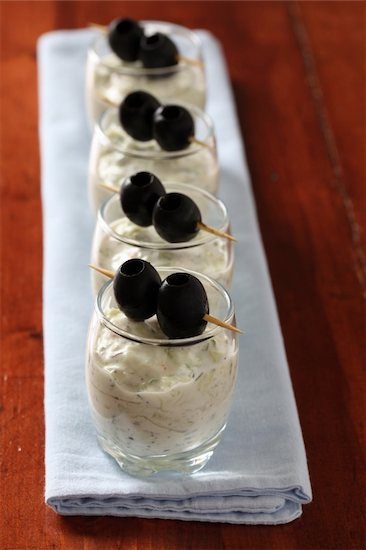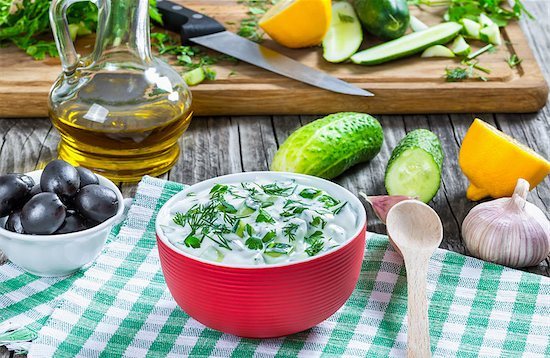Anatolian Yogurt
Anatolian Yogurt is a food which is often taken for granted in American households, but that is the far different case in Turkish households. There are umpteen different varieties and brands of yogurt available in supermarkets, but if you ask the average American how yogurt is made, you might not get one correct answer out of 10.
In Turkey, almost everyone knows how to make Anatolian yogurt, and the skills and knowledge needed to prepare Anatolian yogurt are quickly learned in almost all households. As you might infer from the above, this is a dish which is highly appreciated in Turkey, and that has been true for centuries. Turkish yogurt is made from the milk of sheep, goats, cows, and buffalo, although cow milk is preferred for commercial production.

Anatolian yogurt is a delicacy to be enjoyed with olives and other delicious treats.
However, the various milk sources do contribute strongly to the wide variety of textures and tastes which are available throughout Turkey. Everyone seems to have their favorite kind of Anatolian yogurt, with some Turkish people preferring buffalo milk yogurt because of its rich content of fat, it’s thick texture, and the flavorful kaymak present on the top of the mixture.
Various Turkish Versions of Yogurt
There are some significant differences to how yogurt is made in Anatolia versus how it’s made commercially in the US, and in fact, there are many aspects of yogurt production which are different between the two global communities. American yogurt lovers might be shocked to learn that yogurt is often made in a traditional bucket called a bakrac for home usage, although plastic is preferred by commercial enterprises.
Many Turkish cities have their own distinctive version of the dairy treat, with Denizli well known for its yanik yogurt, which is a kind of burnt version, created from several different milk sources, depending on seasonal availability. The burnt flavor is derived from the casein in milk which becomes caramelized when raw milk is heated in hot cooking receptacles.
Turkish Uses of Anatolian Yogurt
Surprisingly, yogurt is not generally consumed at breakfast meals in Turkish households but is instead more often served as an accompaniment for other main dishes. It’s also used as an ingredient for cooking other dishes and in baking or dessert-making. Yogurt soup is called corbasi in Turkey, and it is a well-known concoction, primarily comprised of dried mint, stock, rice, yogurt, and poached eggs, then topped with a drizzling of butter and garlic yogurt. This soup is highly prized, and it is considered to be a dish worthy of the sultans themselves in Turkish culture.
Another favorite dish which is prepared using Anatolian yogurt is cacik, which is a motley kind of salad including cucumbers which have been cubed, shredded, or diced, dill, mint, garlic, yogurt, and olive oil drizzled on top.
Haydari is a traditional spread beloved by Turkish people, and which is made with garlic, mint, and drained the Anatolian yogurt. A traditional dinner entrée called yogurtlu patlican salatasi is made with eggplants which have been roasted and mashed, garlic, and yogurt.
For an enticing side dish, kizartma can be prepared as a seasonal fried vegetable dish, which includes potatoes, eggplants, pepper, courgettes, and either tomato sauce or yogurt sauce.
Another Turkish favorite is the wrapped or stuffed vegetable dish called sarma and dolma, which is most often cooked with mincemeat, and garnished with yogurt on the side before serving. For an all-out feast, Turkish people love to prepare yogurtlu kebap, which consists of mincemeat with meat kebabs fixed on a skewer and grilled over charcoal heat. These grilled kebabs are then served over the top of tirnak pide and yogurt, with a tomato sauce accompaniment.
A favored by bayram dish is yuvarlama, which is a kind of dumpling stew that includes chick peas, meat, and yogurt. Another type of stew dish favored in many Turkish households is siveydiz, which is prepared seasonally when spring onions are available, and then mixed with garlic, meat, and yogurt.
In the area of desserts, revani is a traditional Turkish dessert which is made from flour, semolina, and yogurt, then baked in the same manner as a cake would be, and served right out of the oven with a tiny bit of syrup on top. There are a number of other Turkish desserts which make liberal use of yogurt, bur revani is one of the most beloved by the populace.
There are countless other variations on all these entrées and side dishes which virtually all Turkish families love to prepare, and all of them serve to emphasize the fact that yogurt is such an important component in Turkish meal preparation. Cooking and baking which includes yogurt in all three meals are so prevalent throughout Turkey that there are a number of good cookbooks and which have hundreds of recipes listed, both traditional and contemporary, and which are frequently consulted by yogurt lovers.
If you’d like to consult one of these recipe books to learn how to prepare your own tasty Turkish yogurt dishes, you will get a good read from the Silvrim Kaymak, although it is written in Turkish. If you’d like to read a fascinating account by a door-to-door yogurt salesman, get a copy of The Yogurt Man Cometh, which is more of a travelogue authored by Kevin Revolinksi, who was a noted globetrotter as well as a part-time salesman.







